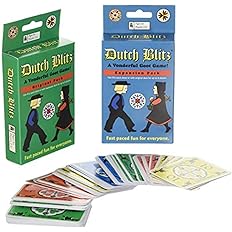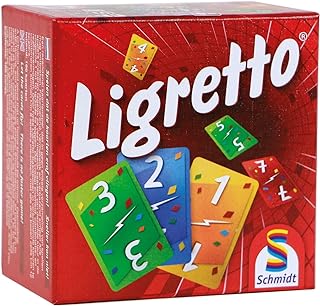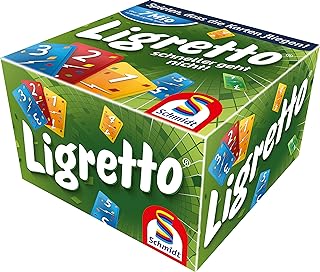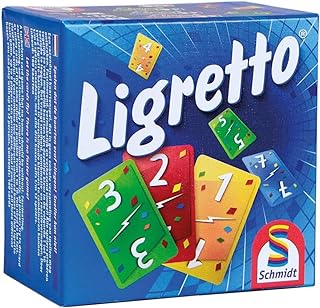Nerts / Pounce / Racing Demon
The description on this page is based on contributions from Joe Childers, Scott D Rhodes, Larry Charbonneau, Steven Toillon, Jesse, Matt Beeken and Adam Joshua Smargon.
- Introduction
- Players
- Initial setup
- The play
- Work piles
- Nerts pile
- Foundations
- Stock and waste pile
- Scoring
- Partnership Game
- Variations
- Commercial versions of Nerts: Dutch Blitz, Ligretto, Solitaire Frenzy
- Other Nerts WWW pages
- Nerts Software
Introduction
The game of Nerts is also known as Nertz, Pounce, Racing Demon, Peanuts, Squeal or Scrooge. It is a competitive patience game for two or more players, using a pack of cards for each player (or team). The players race to get rid of the cards from their "Nerts piles" (also known as "Pounce piles", etc. - depending on what you call the game) by building them from the ace up onto common foundations.
Players and cards
There can be two or more players. It is a very good two-player game, a fun game for three or four. With five people playing as individuals it begins to get out of hand but with an even number of players from six upwards you can play a partnership version; partners sit next to each other and share a pack.
Each player or team needs a standard 52-card pack - the cards ranking A(low) 2 3 4 5 6 7 8 9 10 J Q K(high). Each deck must have a different back design. There is a variation in which two jokers are added to each deck.
Initial setup
Each player deals a Nerts pile (Pounce pile) of thirteen cards in one pile, twelve cards face down and the thirteenth face up on top. Next to this pile, each player deals four cards face-up, side by side and not overlapping, to begin four work piles. The remainder of each player's cards are held face-down as a stock; these cards will be turned three at a time onto a face up stack, forming the player's waste pile.
Players need to arrange themselves and their tableaus in a triangle, box, circle, etc. around a common area that all players can access easily. The common area is where the foundations will be placed and built on.
The layout of a game of Nerts / Pounce in progress looks something like this:
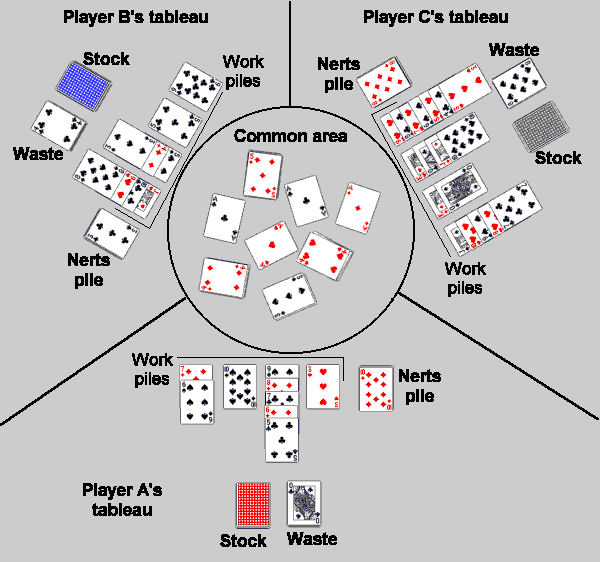
The play
Players play simultaneously as fast as they like, not taking turns, moving cards around their own tableau according to the rules given below, and where possible building on the foundations in the common area. The players' main objective is to eliminate their Nerts piles, by playing cards from them onto their work piles or onto foundations. A player whose Nerts / Pounce pile is exhausted may call "Nerts!" (or "Pounce!"), at which point the game immediately ends. Cards which were in the air being moved from one point to another may complete their move, but no further play is allowed.
It is not necessary to call Nerts! / Pounce! as soon as your Nerts / Pounce pile is empty. You may choose to carry on playing for a while to try to improve your score further.
Players are only allowed to use one hand at a time to move cards, but may hold their stock in their other hand. Only one card at a time may be moved, except when moving a block of cards from one work pile to another. You can only move cards within your own tableau and into the common area. You cannot touch another player's tableau or take cards out of the common area.
If two or more players try to play to the same foundation at the same time, the first played card (generally the one which ends up lowest in the heap) stays there, and all other players must return the equivalent cards they had just tried to play on that same foundation pile to their previous positions. If there is a tie which cannot be resolved, both cards stay.
You are never forced to play a card if it isn't in your best interest - you can always wait.
Work piles
A player's four work piles begin with one card each. Work piles are built in descending order, alternating color, overlapping the cards. Thus a red six is placed on a black seven, a black ten on a red jack, and so on. You can move any card in one of your work piles onto another of your own work piles if it fits, and any cards on top of the card are moved go with it. When a space results, it may be filled by a card from your Nerts pile, your waste pile or another work pile. The exposed cards of each of the four work piles (i.e. the lowest ranked cards of each pile) are available to be played onto the foundations.
If one of your work piles is empty, you are allowed to save time by placing a card underneath a pile if it ranks one higher than the bottom card and is opposite in colour. For example, if you have a work pile headed by a red jack, and another work pile with nothing in it, and the top card of your Nerts pile is a black queen, it is permissible to take the black queen and slide it under the red jack, rather than first putting the black queen in the space and then moving the whole work pile headed by the red jack on top of it.
Nerts / Pounce pile
Cards from the top of your Nerts pile can be played onto empty spaces in your work piles. If they fit, they can also be played onto one of your existing work piles, or they can be played directly onto a foundation. When you have played the top card of your Nerts pile you can turn the next card of the pile face up. When your Nerts pile becomes empty, you are entitled to call "Nerts!" ("Pounce!"), though you need not do so immediately.
Foundations
Foundations piles are built in the common area. They are always begun with an ace, and can be built up by playing the next higher card of the same suit (for example the nine of spades on the eight of spades) until the king is reached. Players can always start new foundation piles by placing any available ace in the common area. Other available cards can be played onto an existing foundation where they fit, provided that another player doesn't get there before you. The cards available for playing to foundation piles are: the top card of the Nerts pile, the exposed cards (lowest ranked cards) of each work pile, and the top card of the waste pile. Any player may play onto any foundation. When a foundation is filled up to king, it is turned over and set aside.
Stock and waste pile
You can turn over cards from your stock three at a time and put them face-up onto your waste pile (the waste pile has no cards at the start of play). Be sure to keep the cards in the same order when you do so. The top card of your waste pile may be played to one of your work piles or to a foundation pile if it fits. If there are only one or two cards left in the stock, place them on the waste pile, and then turn the waste pile over to start a new stock; do not pick up the waste pile and place it underneath so that you can deal three cards.
If it happens that all players are stuck (no further legal moves), or no one wishes to play any more cards, then everyone picks up their waste pile to re-form their stock, and then puts the top card of the stock on the bottom. (This happens frequently in a two-player game and rarely with more players.) If you get stuck but others can still play, you have to wait for everyone else to get stuck (or decide they do not want to make any more moves) before you are allowed to transfer your top stock card to the bottom.
Scoring
When someone calls "Nerts!" (or "Pounce!") play ends and scoring takes place. Each player (team) scores one point for each of their own cards that they managed to play into the common area. To determine this, the foundation piles have to be sorted out according to the owners of the cards - this is why it is necessary that the decks have different backs. All players except the one who called Nerts then subtract two points for every card left in their Nerts pile when play ended. Thus calling Nerts does not guarantee the highest score, but more often than not it does result in a good score.
If all players get so stuck that no card in their stock will play, play stops and the score is calculated as usual. In this case everyone will have to subtract two points for each card that is left in their Nerts pile.
Further deals are played until one or more player's scores reach or pass an agreed target score (usually 100). At this point the player with the highest score wins from each other player in proportion to the difference between their scores.
Partnership Game
Nerts / Pounce can be played by more than five people if they play as partners. Partners will sit next to each other. Each partnership plays just like an individual player except that they are able to help each other out (an extra set of eyes and hands can come in handy). One partner can go through the stock pile three at a time, while the other partner keeps an eye on the Nerts / Pounce pile.
Variations
- Jokers (optional but fun)
- Two Jokers are added to each deck. Jokers can stand for any other card. When played a joker onto a foundation, a player must follow the following protocol: before moving the Joker, the player must announce the rank and suit it represents; only then can the player move the joker onto the foundation. A player may touch a Joker, and even pick it up halfway, but the announcement of rank and suit must be completed before the Joker leaves the pile it is on. The reason for this rule is to give other players a fair chance to realise that they can play the next card top of the joker, denying the player of the joker the chance to get un-stuck by doing the same. When playing Jokers on the work piles no announcement needs to be made. A Joker on top of a work pile or on the Nerts or waste pile can be placed on any work pile without a thought. If a regular card is moved onto a Joker, however, the Joker's rank and color are fixed until the cards above it are removed. Jokers score like any other cards.
- Number of cards dealt to Nerts / Pounce pile
- Rather than 13 cards, some people deal 12 cards (11 face down and one face up), and some deal 11 cards (10 face down and one face up).
- Scoring variations
- Some people award a bonus of 25 points to the player who calls "Pounce!".
- Some people deduct only one point for each card remaining in a player's Nerts / Pounce pile.
- Some people, rather than totalling the score over a series of hands, play each hand as a separate event in which the player with the highest score wins.
- Turning cards from stock pile onto waste pile
- Some players reverse the order of each set of three cards, so that the card which was on top of the stock becomes the card which is uppermost on the waste pile.
- Some play that the stock cards are turned up onto the waste pile one at a time rather than three at a time.
- Hand instead of waste pile
- Some play that each player has a stockpile and a hand of 7 cards. Cards may be played from the hand to the waste piles or common area, and after playing cards from hand, new cards may be drawn from the discard pile to replenish the hand up to 7 cards but never more than 7. The players have no discard pile. This variant may be characteristic of the variant of this game known as "Scrooge". In this version it is possible, especially with two players, for the game to become blocked with all playable cards buried in the players' stock piles or Nerts / Pounce piles. I suggest that if this happens, all players should show their hands to prove they have no playable card - if any playable card is found, the owner is obliged to play it and the game continues. If there is really no play for enyone, all players place their 7 hand cards on the bottom of their stock piles, draw 7 new cards from the top of their stock piles, and when all are ready the game continues. If any players have other ways of handling this situation, please let me know.
Commercial Versions of Nerts
Dutch Blitz® is another commercial game closely related to Nerts. It is sold as a Pennsylvania Dutch card game. It consists of four decks of 40 cards containing numerals from 1 to 10 only. The Blitz pile is the equivalent of the Nerts pile and contains 10 cards at the start. The post piles are the equivalent of the work piles - each player has five post piles in the two player game, but only three post piles when there are more than two players. The waste pile becomes a wood pile, and the foundation piles are called Dutch piles. It may be that on religious grounds the Pennsylvania Dutch are offended by the picture cards in the regular playing-card deck, and this could explain the existence of this version with numerals only. Rook cards are used by some Protestant communities in the American mid-west for similar reasons. You can order Dutch Blitz from amazon.com.
Ligretto is a German proprietary version of the same game, which apart from the card design is almost identical to Dutch Blitz. Each player has a pack of 40 cards, numbered 1 to 10 in four colours. The tableaux in this game consist just of a row of three cards (or more with fewer than 4 players) with no building allowed. One game box contains 160 cards - enough for four players, but boxes are available in various colours and themes, and by combining these more players can be accommodated. You can order Ligretto from amazon.com.
Solitaire Frenzy is another commercial Pounce / Racing Demon game, from JAX.
Other Nerts WWW pages
Here is a link to Larry Charbonneau's Nertz Page, which has another account of the rules.
The National Nertz Association aims to promote and develop the game of Nertz in the USA. Their web site has details of tournaments, online games, a chat room and other information and resources.
Here is Chuck Jones' How to Play Pounce page, which provides illustrated rules, including a video clip.
Here is an archive copy of Air Hadoken's Pounce page, which described another version, in which each player has five work piles arranged as for Klondike solitaire.
In the Game Cabinet there is a letter from Mark Delano giving rules of Nerts.
Nerts Software
JD Software offers a Nertz/Pounce app for playing against live opponents or against the computer using an Android phone or iPhone or on the web.
Zachtronics have produced a free online Nerts game that runs on the Steam gaming platform.
